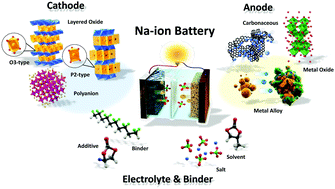当前位置:
X-MOL 学术
›
Chem. Soc. Rev.
›
论文详情
Our official English website, www.x-mol.net, welcomes your feedback! (Note: you will need to create a separate account there.)
Sodium-ion batteries: present and future
Chemical Society Reviews ( IF 46.2 ) Pub Date : 2017-03-28 00:00:00 , DOI: 10.1039/c6cs00776g Jang-Yeon Hwang 1, 2, 3, 4 , Seung-Taek Myung 4, 5, 6, 7 , Yang-Kook Sun 1, 2, 3, 4
Chemical Society Reviews ( IF 46.2 ) Pub Date : 2017-03-28 00:00:00 , DOI: 10.1039/c6cs00776g Jang-Yeon Hwang 1, 2, 3, 4 , Seung-Taek Myung 4, 5, 6, 7 , Yang-Kook Sun 1, 2, 3, 4
Affiliation

|
Energy production and storage technologies have attracted a great deal of attention for day-to-day applications. In recent decades, advances in lithium-ion battery (LIB) technology have improved living conditions around the globe. LIBs are used in most mobile electronic devices as well as in zero-emission electronic vehicles. However, there are increasing concerns regarding load leveling of renewable energy sources and the smart grid as well as the sustainability of lithium sources due to their limited availability and consequent expected price increase. Therefore, whether LIBs alone can satisfy the rising demand for small- and/or mid-to-large-format energy storage applications remains unclear. To mitigate these issues, recent research has focused on alternative energy storage systems. Sodium-ion batteries (SIBs) are considered as the best candidate power sources because sodium is widely available and exhibits similar chemistry to that of LIBs; therefore, SIBs are promising next-generation alternatives. Recently, sodiated layer transition metal oxides, phosphates and organic compounds have been introduced as cathode materials for SIBs. Simultaneously, recent developments have been facilitated by the use of select carbonaceous materials, transition metal oxides (or sulfides), and intermetallic and organic compounds as anodes for SIBs. Apart from electrode materials, suitable electrolytes, additives, and binders are equally important for the development of practical SIBs. Despite developments in electrode materials and other components, there remain several challenges, including cell design and electrode balancing, in the application of sodium ion cells. In this article, we summarize and discuss current research on materials and propose future directions for SIBs. This will provide important insights into scientific and practical issues in the development of SIBs.
中文翻译:

钠离子电池:现在和将来
能源生产和存储技术在日常应用中引起了极大的关注。近几十年来,锂离子电池(LIB)技术的进步改善了全球的生活条件。LIB用于大多数移动电子设备以及零排放电子车辆。然而,由于可再生能源和智能电网的可用水平有限以及随之而来的预期价格上涨,人们越来越关注可再生能源和智能电网的负荷水平以及锂源的可持续性。因此,仅LIB是否能满足对小型和/或中大型的能量存储应用不断增长的需求仍不清楚。为了减轻这些问题,最近的研究集中在替代储能系统上。钠离子电池(SIB)被认为是最佳的候选电源,因为钠的用途广泛,并且化学性质与LIB相似。因此,SIB有望成为下一代替代产品。近来,已经引入了钠化层过渡金属氧化物,磷酸盐和有机化合物作为SIB的阴极材料。同时,通过使用精选的含碳材料,过渡金属氧化物(或硫化物)以及金属间化合物和有机化合物作为SIB的阳极,促进了最近的发展。除了电极材料以外,合适的电解质,添加剂和粘合剂对于开发实用的SIB来说同样重要。尽管电极材料和其他组件得到了发展,但仍然存在一些挑战,包括电池设计和电极平衡,在钠离子电池的应用中。在本文中,我们总结并讨论了当前对材料的研究,并提出了SIB的未来发展方向。这将为开发SIB的科学和实践问题提供重要见解。
更新日期:2017-05-04
中文翻译:

钠离子电池:现在和将来
能源生产和存储技术在日常应用中引起了极大的关注。近几十年来,锂离子电池(LIB)技术的进步改善了全球的生活条件。LIB用于大多数移动电子设备以及零排放电子车辆。然而,由于可再生能源和智能电网的可用水平有限以及随之而来的预期价格上涨,人们越来越关注可再生能源和智能电网的负荷水平以及锂源的可持续性。因此,仅LIB是否能满足对小型和/或中大型的能量存储应用不断增长的需求仍不清楚。为了减轻这些问题,最近的研究集中在替代储能系统上。钠离子电池(SIB)被认为是最佳的候选电源,因为钠的用途广泛,并且化学性质与LIB相似。因此,SIB有望成为下一代替代产品。近来,已经引入了钠化层过渡金属氧化物,磷酸盐和有机化合物作为SIB的阴极材料。同时,通过使用精选的含碳材料,过渡金属氧化物(或硫化物)以及金属间化合物和有机化合物作为SIB的阳极,促进了最近的发展。除了电极材料以外,合适的电解质,添加剂和粘合剂对于开发实用的SIB来说同样重要。尽管电极材料和其他组件得到了发展,但仍然存在一些挑战,包括电池设计和电极平衡,在钠离子电池的应用中。在本文中,我们总结并讨论了当前对材料的研究,并提出了SIB的未来发展方向。这将为开发SIB的科学和实践问题提供重要见解。



























 京公网安备 11010802027423号
京公网安备 11010802027423号